Picosecond Laser Ablation of Polyhydroxyalkanoates (PHAs): Comparative Study of Neat and Blended Material Response
Abstract
1. Introduction
2. Materials and Methods
2.1. Materials
2.2. Laser Irradiation
3. Results
3.1. Neat PHAs
3.2. PHA Blend
3.3. Effects of Pulse Overlapping on the Blend
4. Discussion
5. Conclusions
Author Contributions
Funding
Acknowledgments
Conflicts of Interest
References
- Koller, M. Biodegradable and Biocompatible Polyhydroxy-alkanoates (PHA): Auspicious microbial macromolecules for pharmaceutical and therapeutic applications. Molecules 2018, 23, 362. [Google Scholar] [CrossRef]
- Wang, L.; Wang, Z.H.; Shen, C.Y.; You, M.L.; Xiao, J.F.; Chen, G.Q. Differentiation of human bone marrow mesenchymal stem cells grown in terpolyesters of 3-hydroxyalkanoates scaffolds into nerve cells. Biomaterials 2010, 31, 1691–1698. [Google Scholar] [CrossRef]
- Lizarraga-Valderrama, L.R.; Nigmatullin, R.; Taylor, C.; Haycock, J.W.; Claeyssens, F.; Knowles, J.C.; Roy, I. Nerve tissue engineering using blends of poly(3-hydroxyalkanoates) for peripheral nerve regeneration. Eng. Life Sci. 2015, 15, 612–621. [Google Scholar] [CrossRef]
- Basnett, P.; Ching, K.Y.; Stolz, M.; Knowles, J.C.; Boccaccini, A.R.; Smith, C.; Locke, I.C.; Keshavarz, T.; Roy, I. Novel Poly(3-hydroxyoctanoate)/Poly(3-hydroxybutyrate) blends for medical applications. React. Funct. Polym. 2013, 73, 1340–1348. [Google Scholar] [CrossRef]
- Shishatskaya, E.I.; Volova, T.G.; Puzyr, A.P.; Mogilnaya, O.A. Tissue response to the implantation of biodegradable polyhydroxyalkanoate sutures. J. Mater. Sci. Mater. Med. 2004, 15, 719–728. [Google Scholar] [CrossRef] [PubMed]
- Lizarraga-Valderrama, L.R.; Taylor, C.S.; Claeyssens, F.; Haycock, J.W.; Knowles, J.C.; Roy, I. Unidirectional neuronal cell growth and differentiation on aligned polyhydroxyalkanoate blend microfibres with varying diameters. J. Tissue Eng. Regen. Med. 2019, 13, 1581–1594. [Google Scholar] [CrossRef] [PubMed]
- Laycock, B.; Halley, P.; Pratt, S.; Werker, A.; Lant, P. The chemomechanical properties of microbial polyhydroxyalkanoates. Prog. Polym. Sci. 2014, 39, 397–442. [Google Scholar] [CrossRef]
- Sathya, A.B.; Sivasubramanian, V.; Santhiagu, A.; Jyothy, V.B.; Sivashankar, R. Biological significance and advances in application of polyhydroxyalkanoate. J. Adv. Eng. Res. 2017, 4, 73–88. [Google Scholar]
- Zhang, J.; Shishatskaya, E.I.; Volova, T.G.; Ferreira da Silva, L.; Chen, G.Q. Polyhydroxyalkanoates (PHA) for therapeutic applications. Mater. Sci. Eng. C 2018, 86, 144–150. [Google Scholar] [CrossRef]
- Valle, J.; Burgui, S.; Langheinrich, D.; Gil, C.; Solano, C.; Toledo-Arana, A.; Helbig, R.; Lasagni, A.; Lasa, I. Evaluation of surface microtopography engineered by direct laser interference for bacterial anti-biofouling. Macromol. Biosci. 2015, 15, 1060–1069. [Google Scholar] [CrossRef]
- Newman, P.; Galenano-Niño, J.L.; Graney, P.; Razal, J.M.; Minett, A.I.; Ribas, J.; Ovalle-Robles, R.; Biro, M.; Zreiqat, H. Relationship between nanotopographical alignment and stem cell fate with live imaging and shape analysis. Sci. Rep. 2016, 6, 37909. [Google Scholar] [CrossRef] [PubMed]
- Riveiro, A.; MaÇon, A.L.B.; del Val, J.; Comesaña, R.; Pou, J. Laser surface texturing of polymers for biomedical applications. Front. Phys. 2018, 6, 16. [Google Scholar] [CrossRef]
- Wang, Z.; Zhou, R.; Wen, F.; Zhang, R.; Ren, L.; Swee, H.T.; Hong, M. Reliable laser fabrication: The quest for responsive biomaterials surface. J. Mater. Chem. B 2018, 6, 3612–3631. [Google Scholar] [CrossRef]
- Lootz, D.; Behrend, D.; Kramer, S.; Freier, T.; Haubold, A.; BenkieBer, G.; Schmitz, K.P.; Becher, B. Laser cutting: Influence on morphological and physicochemical properties of polyhydroxybutyrate. Biomaterials 2001, 22, 2447–2452. [Google Scholar] [CrossRef]
- Ellis, G.; Cano, P.; Jadraque, M.; Martin, M.; Lopez, L.; Nuñez, T.; de la Peña, E.; Marco, C.; Garrido, L. Laser microperforated biodegradable microbial polyhydroxyalkanoate substrates for tissue repair strategies an infrared microspectroscopy study. Anal. Bioanal. Chem. 2011, 399, 2379–2388. [Google Scholar] [CrossRef]
- Slabko, V.V.; Volova, T.G.; Krasnov, P.O.; Kuzubov, A.A.; Shishatskaya, E.I. Surface modification of bioresorbable polymer scaffolds by laser treatment. Cell. Biophys. 2010, 55, 234–238. [Google Scholar] [CrossRef]
- Volova, T.G.; Tarasevich, A.A.; Golubev, A.I.; Boyandin, A.N.; Shumilova, A.A.; Nikolaeva, E.D.; Shishatskaya, E.I. Laser processing of polymer constructs from poly(3-hydroxybutyrate). J. Biomater. Sci. Polym. Ed. 2015, 26, 1210–1228. [Google Scholar] [CrossRef]
- Michaljanicova, I.; Slepicka, P.; Heitz, J.; Barb, R.A.; Sajdl, P.; Svorcik, V. Comparison of KrF and ArF excimer laser treatment of biopolymer surface. Appl. Surf. Sci. 2015, 339, 144–150. [Google Scholar] [CrossRef]
- Ortiz, R.; Quintana, I.; Etxarri, J.; Lejardi, A.; Sarasua, J.R. Picosecond laser ablation of poly-L-lactide: Effect of crystallinity on the material response. J. Appl. Phys. 2011, 110, 094902. [Google Scholar] [CrossRef]
- Ortiz, R.; Aurrekoetxea-Rodríguez, I.; Rommel, M.; Quintana, I.; Vivanco, M.d.M.; Toca-Herrera, J.L. Laser surface microstructuring of a bio-resorbable polymer to anchor stem cells, control adipocyte morphology, and promote osteogenesis. Polymers 2018, 10, 1337. [Google Scholar] [CrossRef]
- Liu, J.M. Simple technique for measurements of pulsed Gaussian-beam spot sizes. Opt. Lett. 1982, 7, 196–198. [Google Scholar] [CrossRef] [PubMed]
- Pettit, G.H.; Sauerbrey, R. Pulsed ultraviolet laser ablation. Appl. Phys. A 1993, 56, 51–63. [Google Scholar] [CrossRef]
- Kansiz, M.; Domínguez-Vidal, A.; McNaughton, D.; Lendl, B. Fourier-transform infrared (FTIR) spectroscopy for monitoring and determining the degree of crystallisation of polyhydroxyalkanoates (PHAs). Anal. Bioanal. Chem. 2007, 388, 1207–1213. [Google Scholar] [CrossRef] [PubMed]
- Prasad, M.; Conforti, P.F.; Garrison, B.J. Interplay between Chemical, Thermal, and Mechanical processes occurring upon laser excitation of poly(methyl methacrylate) and its role in ablation. J. Phys. Chem. C 2009, 113, 11491–11506. [Google Scholar] [CrossRef]
- Conforti, P.F.; Prasad, M.; Garrison, B.J. Elucidating the thermal chemical and mechanical mechanisms of ultraviolet ablation in poly (methyl methacrylate) via molecular dynamics simulations. Acc. Chem. Res. 2008, 41, 915–924. [Google Scholar] [CrossRef]
- Serafetinides, A.A.; Makropoulou, M.I.; Skordoulis, C.D.; Kar, A.K. Ultra-short pulsed laser ablation of polymers. Appl. Surf. Sci. 2001, 180, 42–56. [Google Scholar] [CrossRef]
- Dumont, T.; Bischofberger, R.; Lippert, T.; Wokaun, A. Gravimetric and profilometric measurements of the ablation rates of photosensitive polymers at different wavelengths. Appl. Surf. Sci. 2005, 247, 115–122. [Google Scholar] [CrossRef]
- Raciukaitis, G.; Gedvilas, M. Investigation of UV picosecond laser ablation of polymers. In Proceedings of the Workshop on laser Applications in Europe; International Society for Optics and Photonics: Dresden, Germany, 2005; pp. 70–79. [Google Scholar] [CrossRef]
- Zhigilei, L.V.; Garrison, B.J. Microscopic mechanisms of laser ablation of organic solids in the thermal and stress confinement irradiation regimes. J. Appl. Phys. 2000, 88, 1281. [Google Scholar] [CrossRef]
- Barham, P.J.; Keller, A.; Otun, E.L.; Holmes, P.A. Crystallization and morphology of a bacterial thermoplastic: Poly-3-hydroxybutyrate. J. Mater. Sci. 1984, 19, 2781–2794. [Google Scholar] [CrossRef]

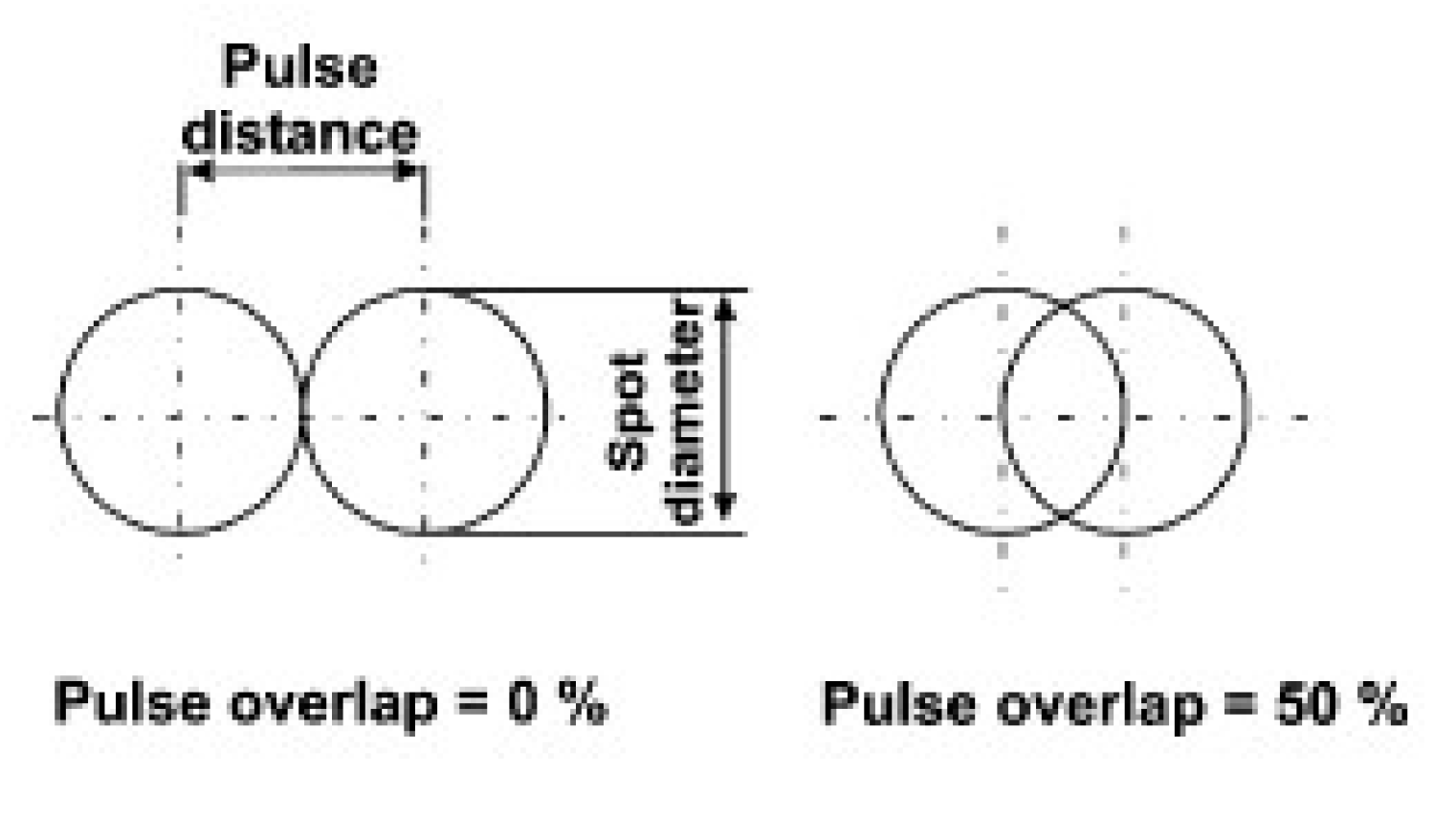

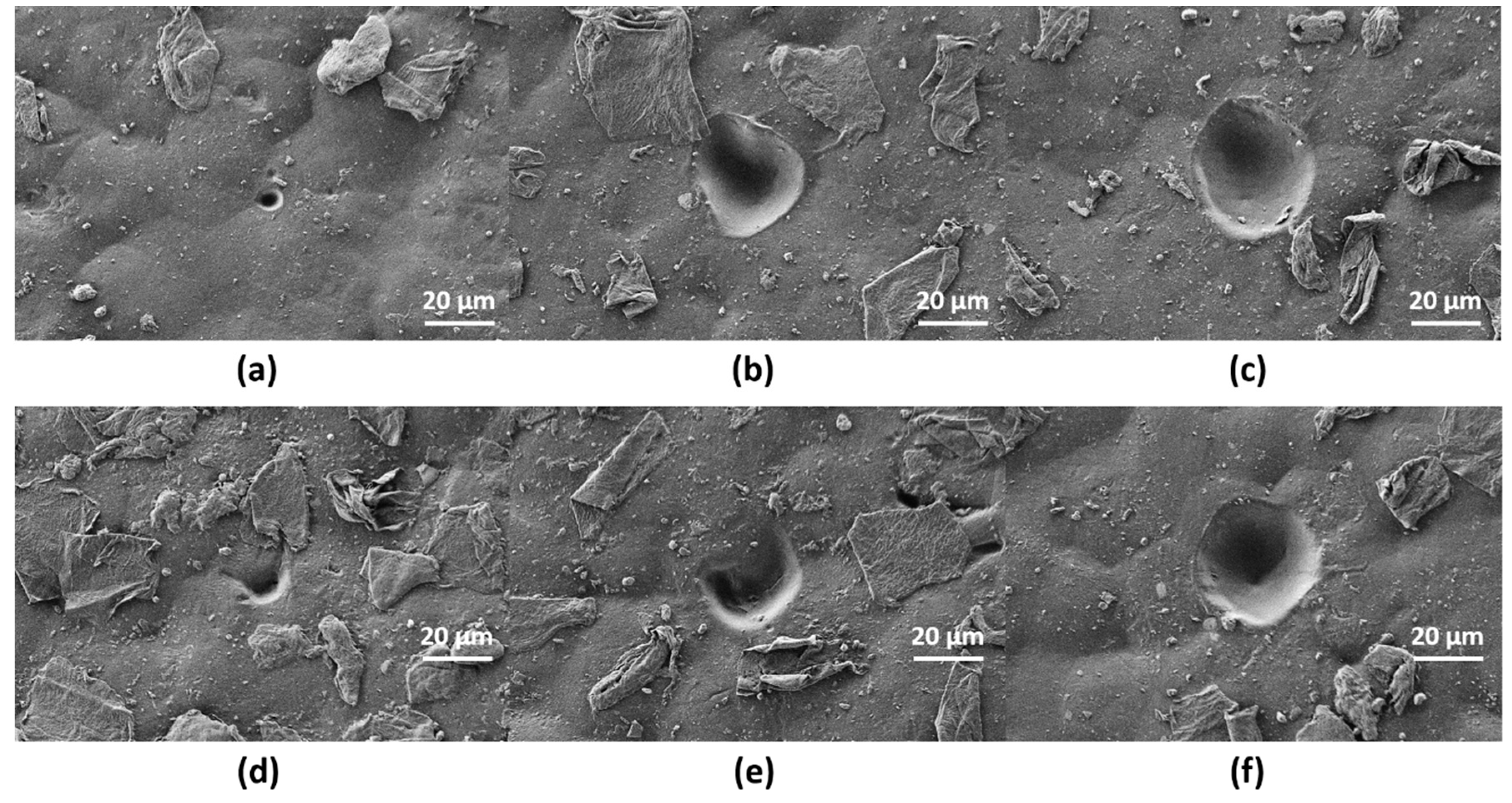
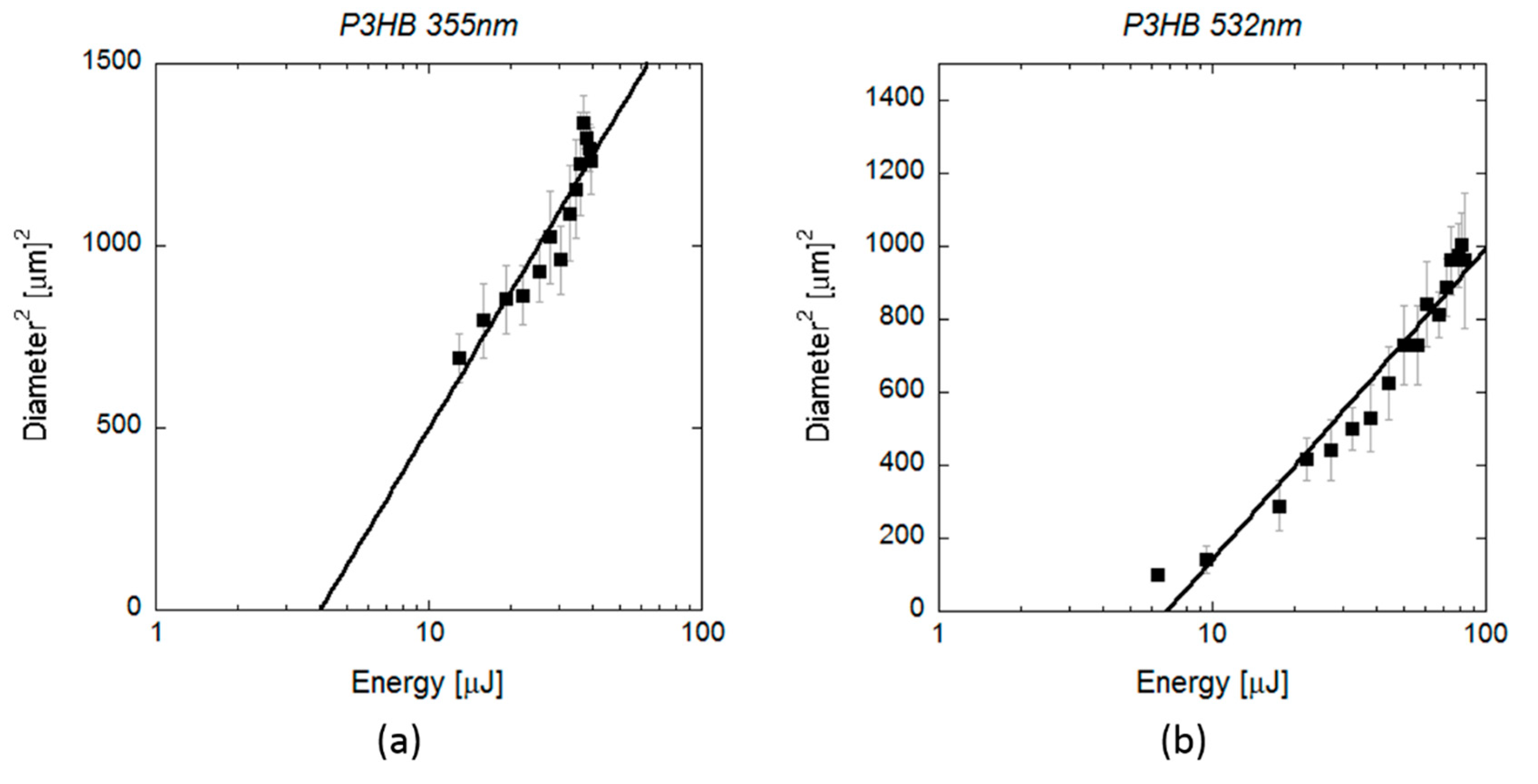
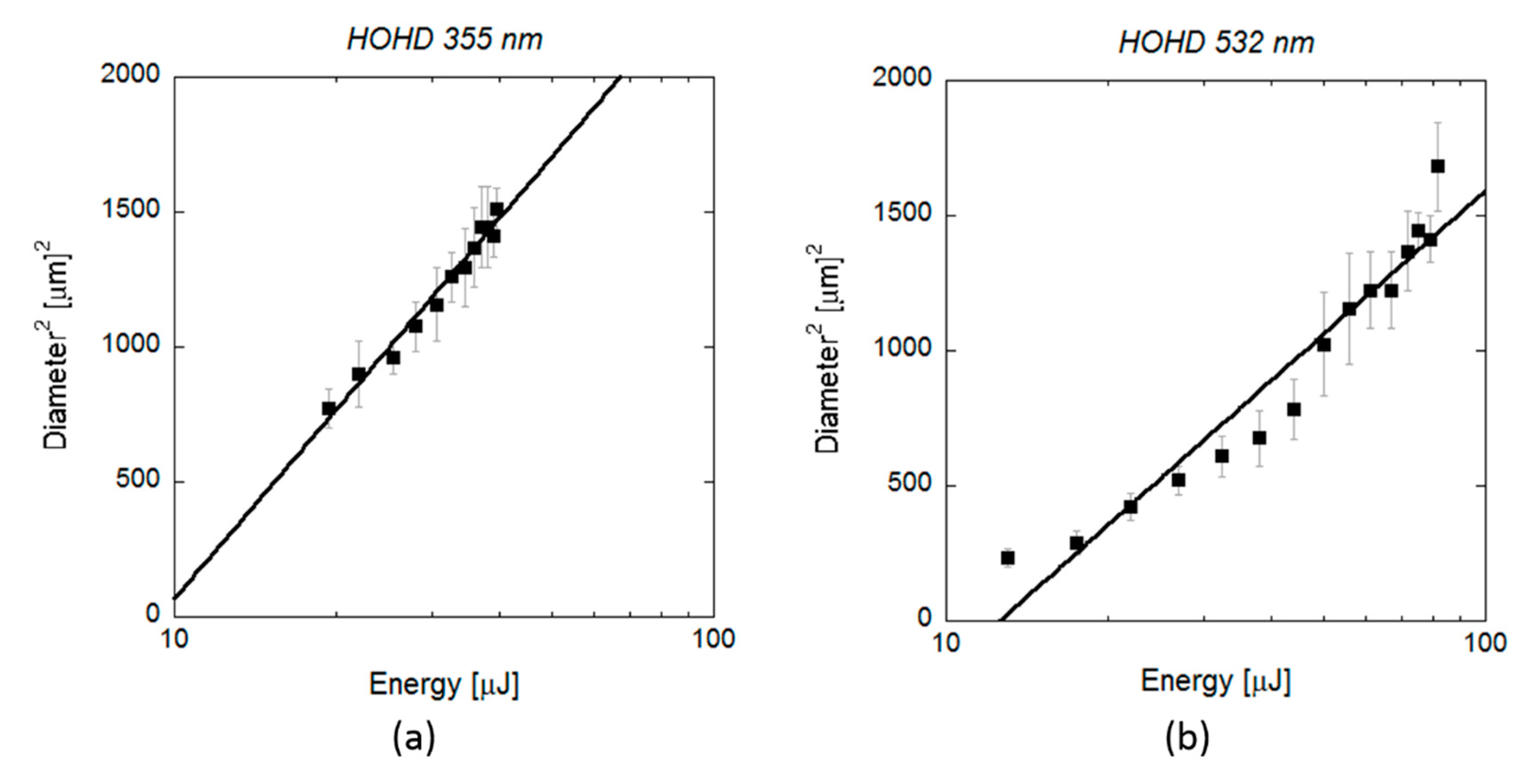
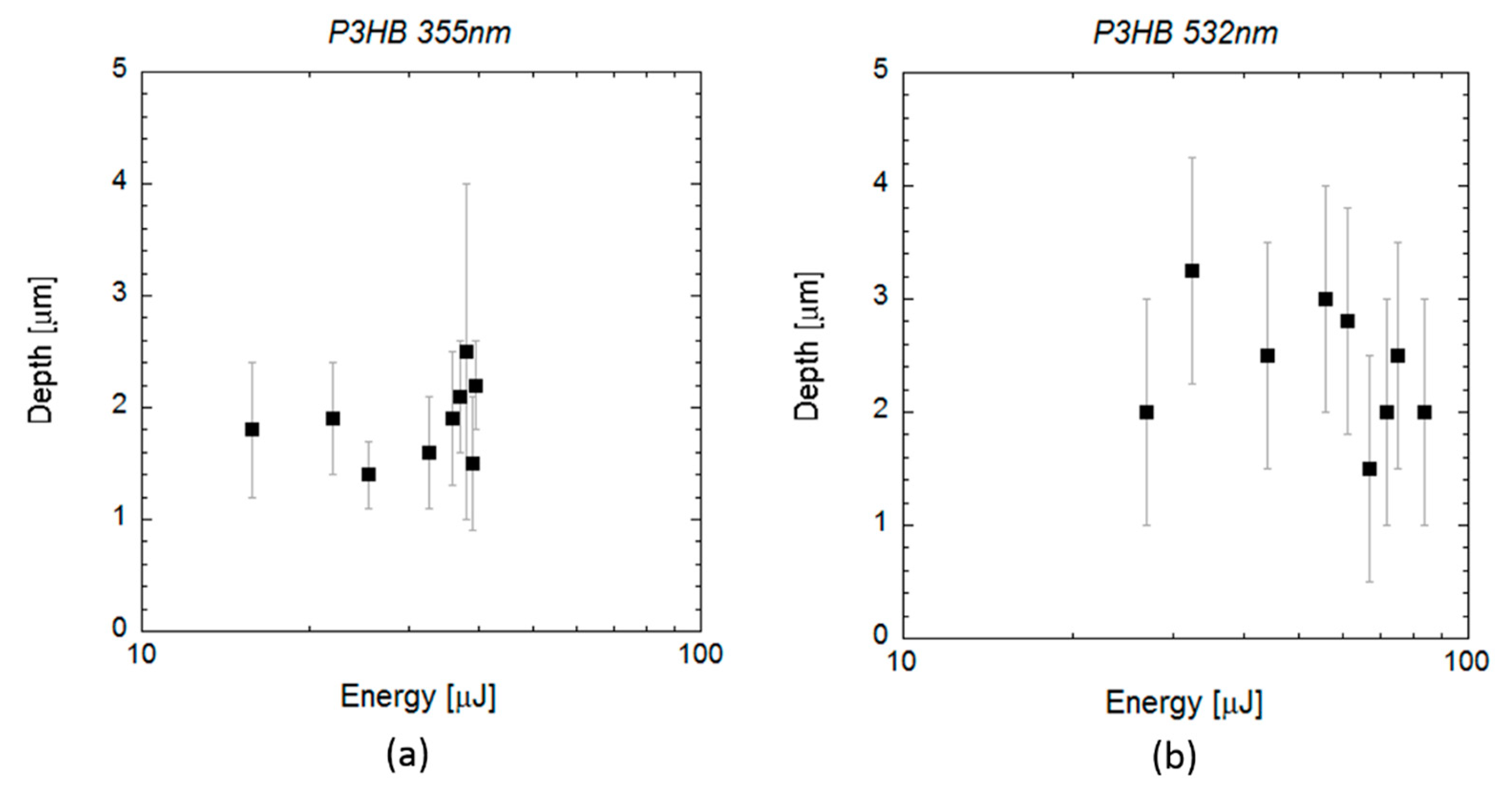
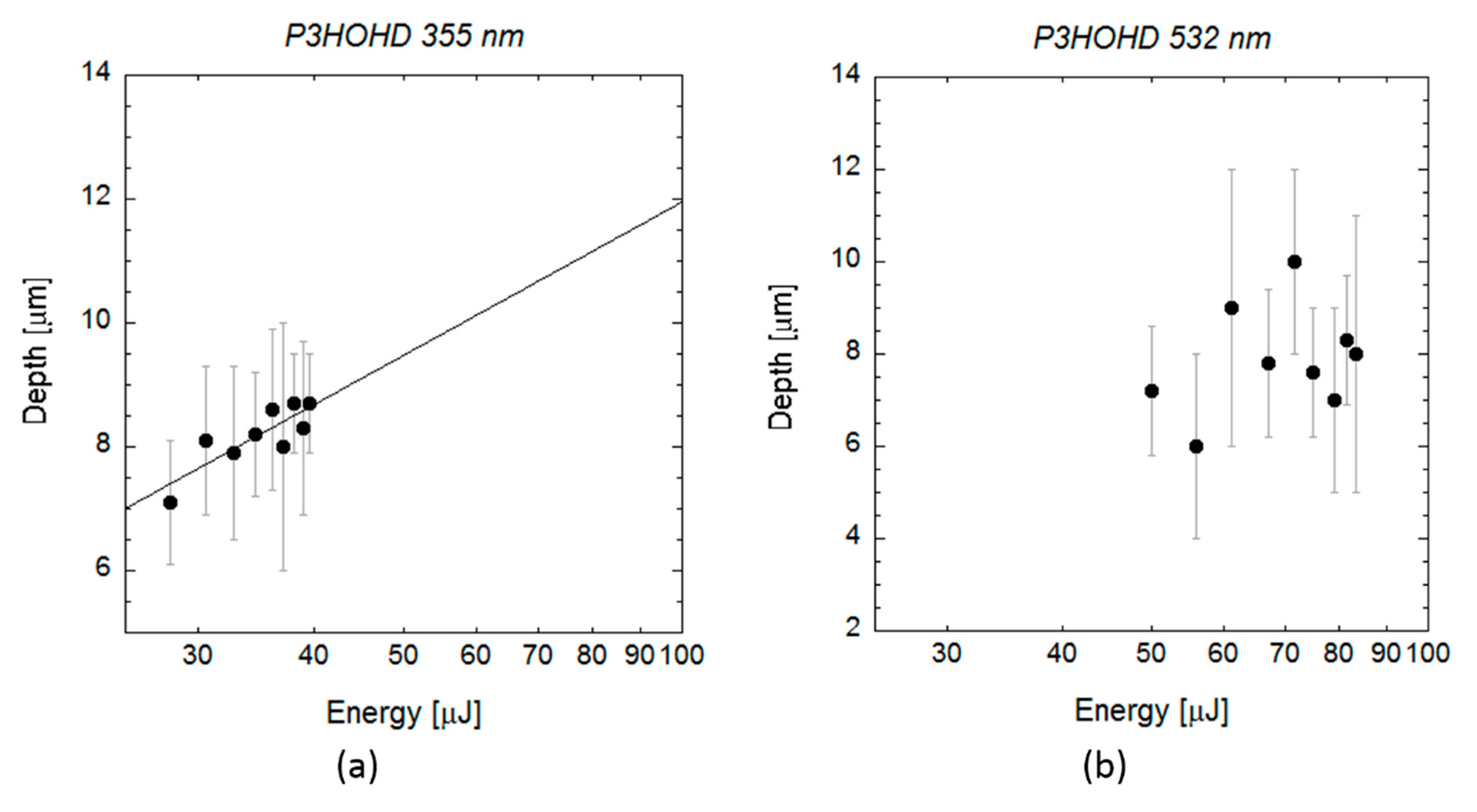
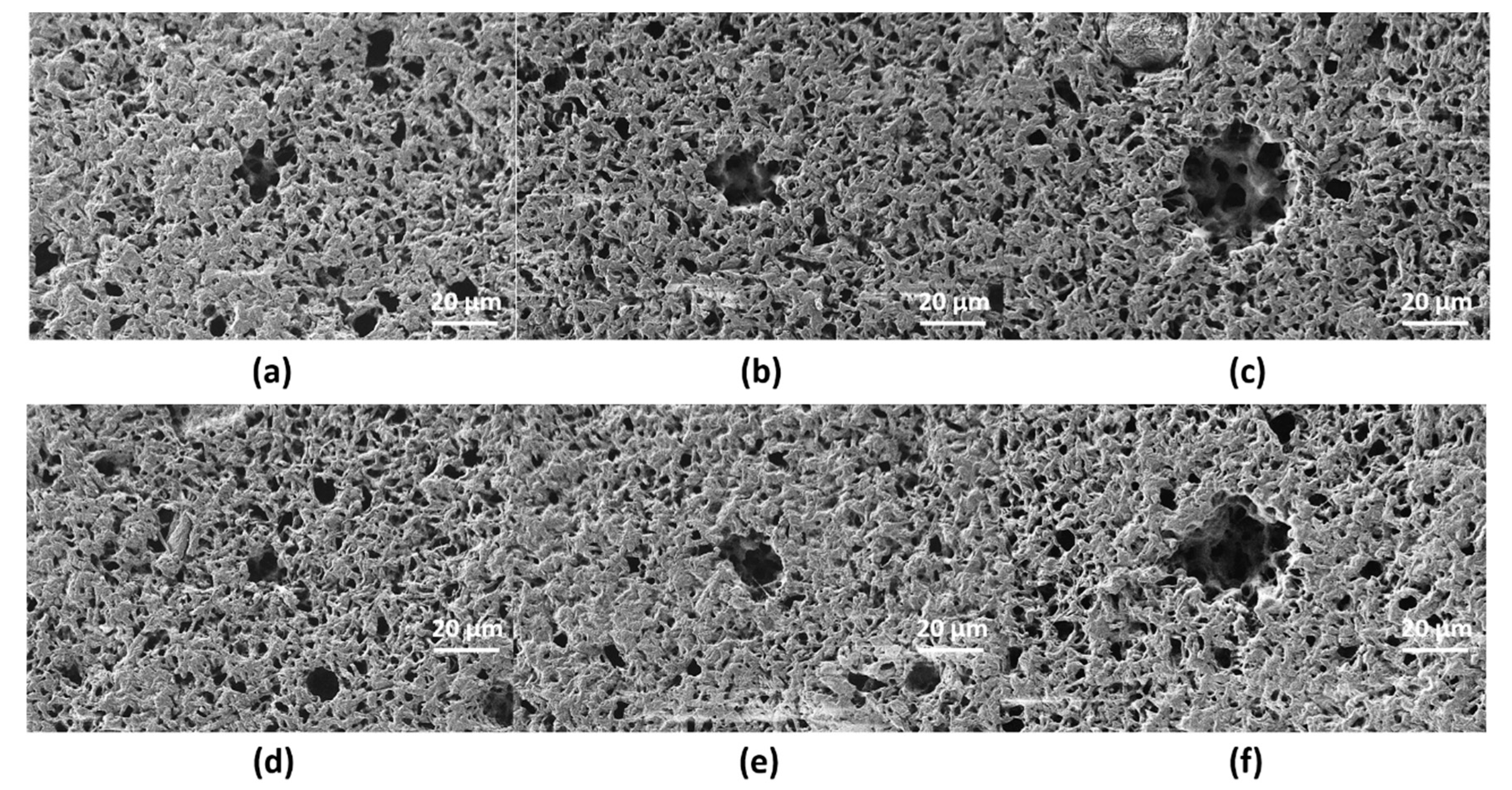
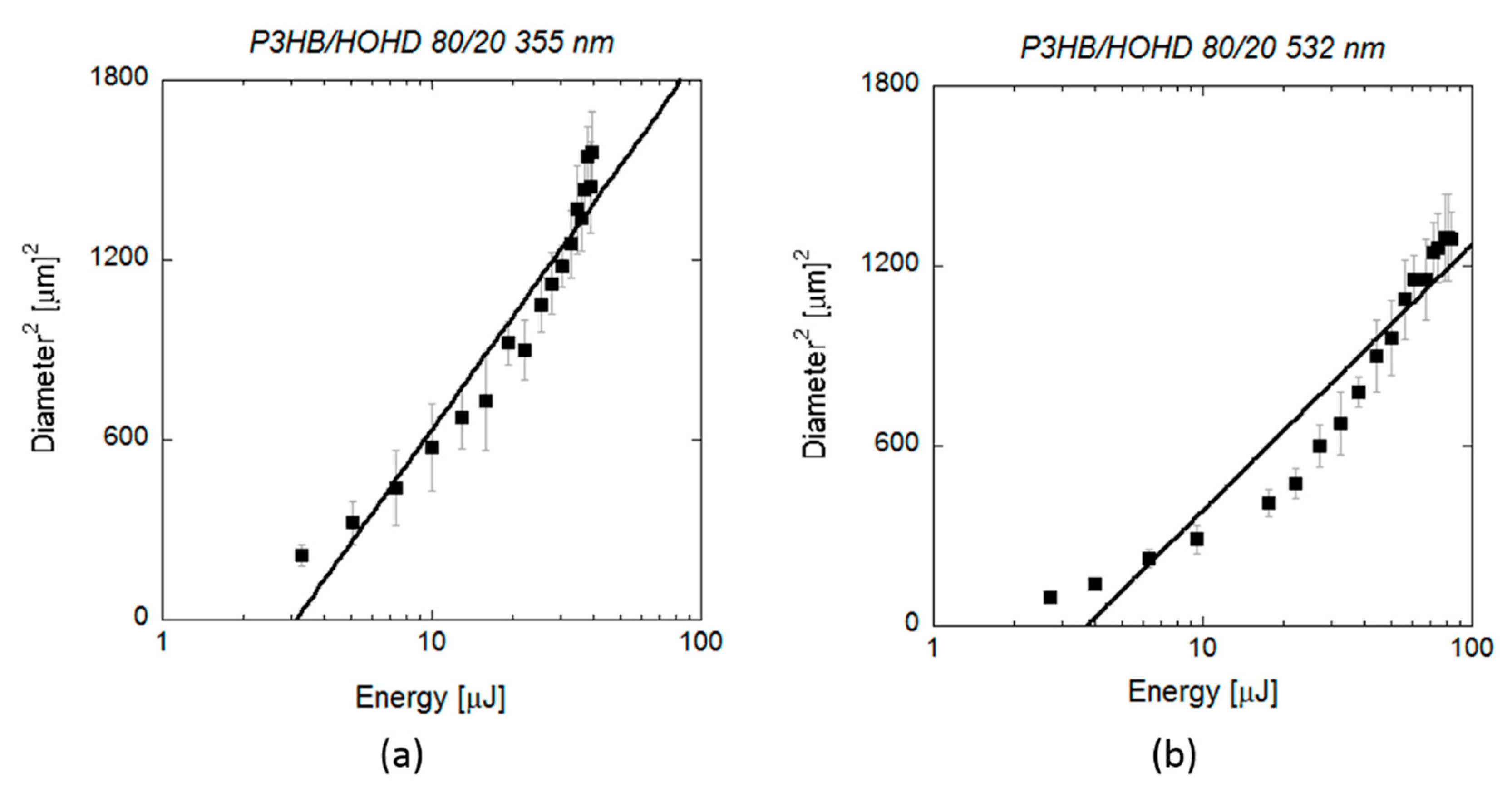
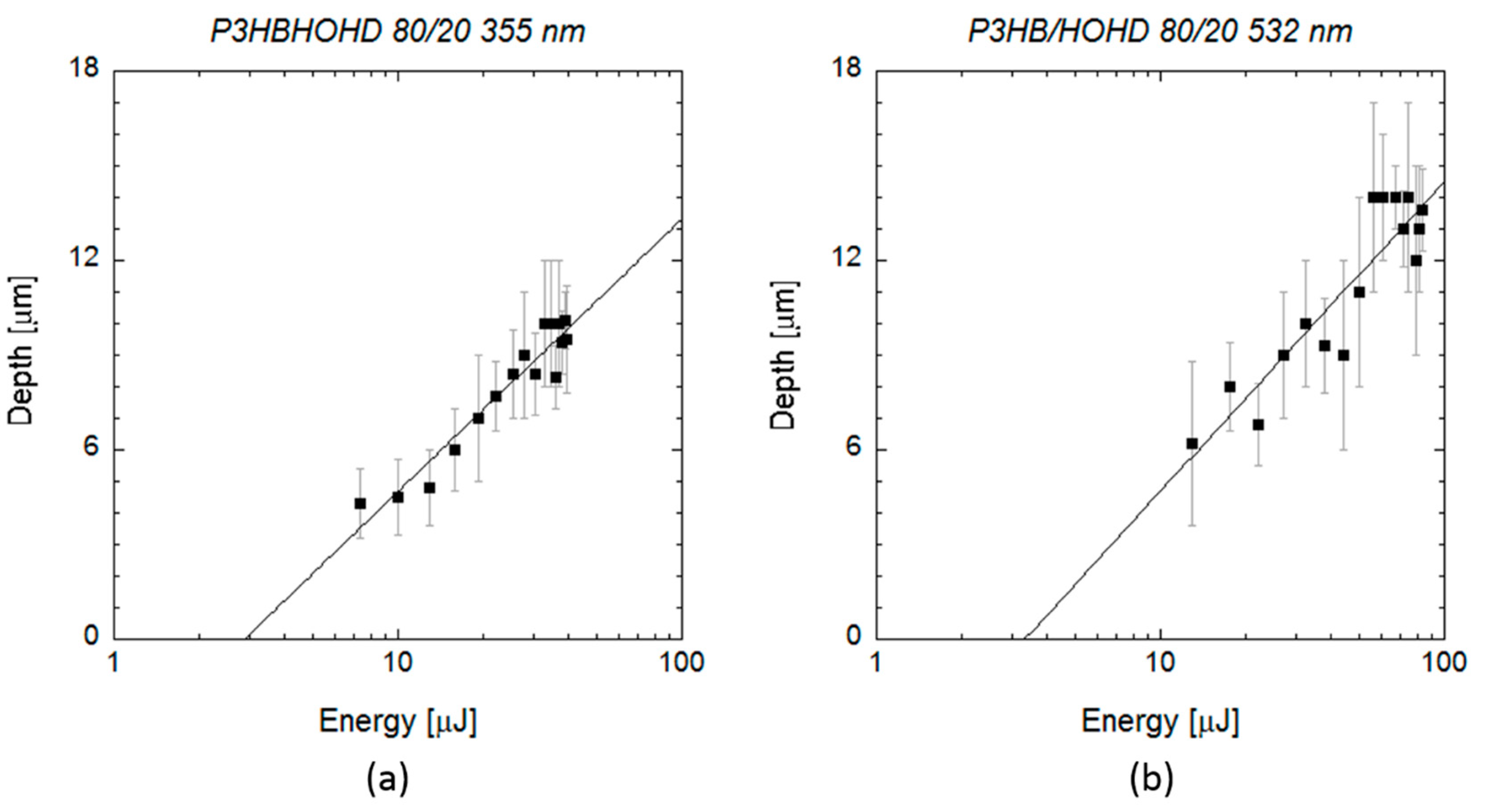
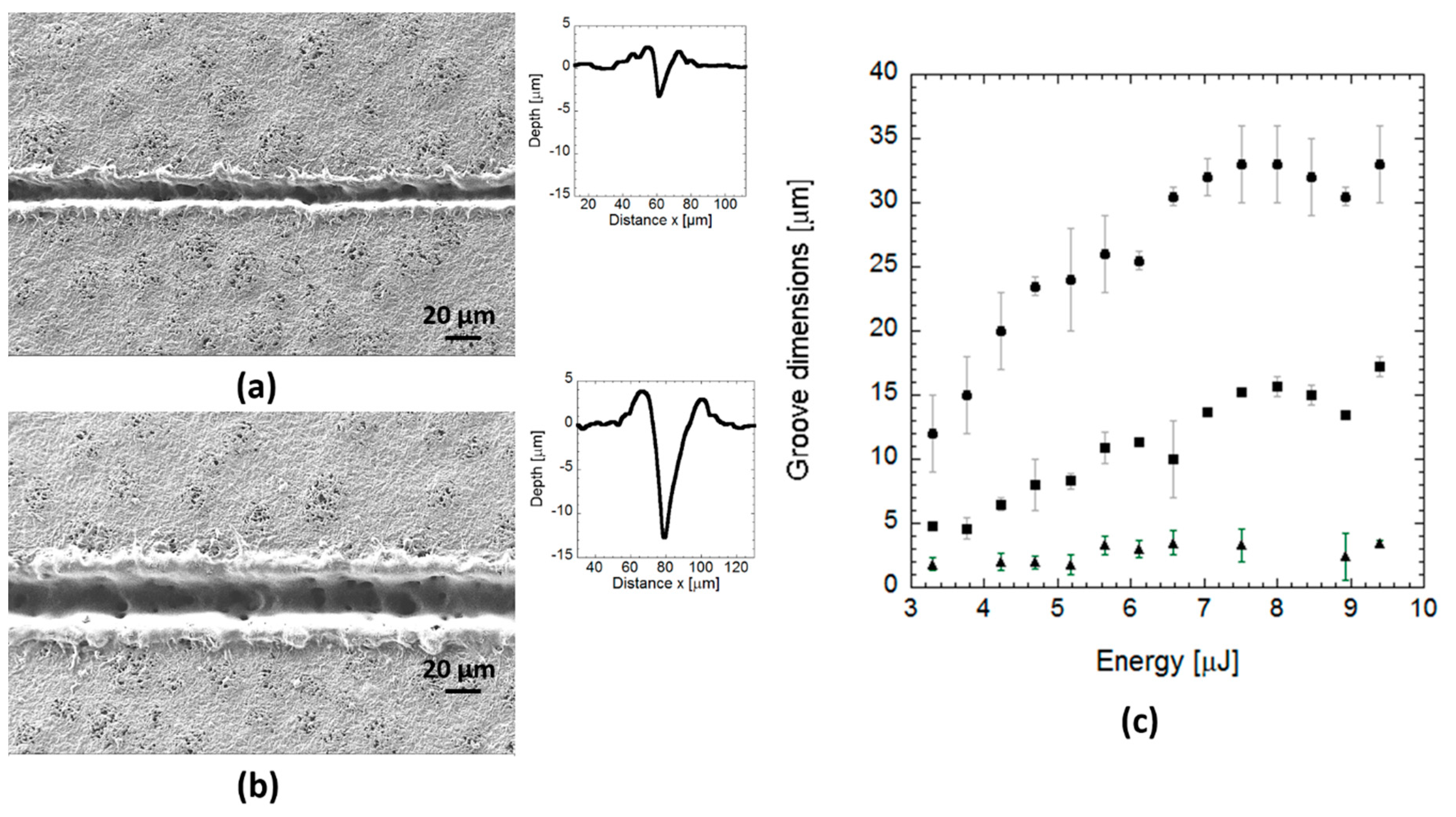
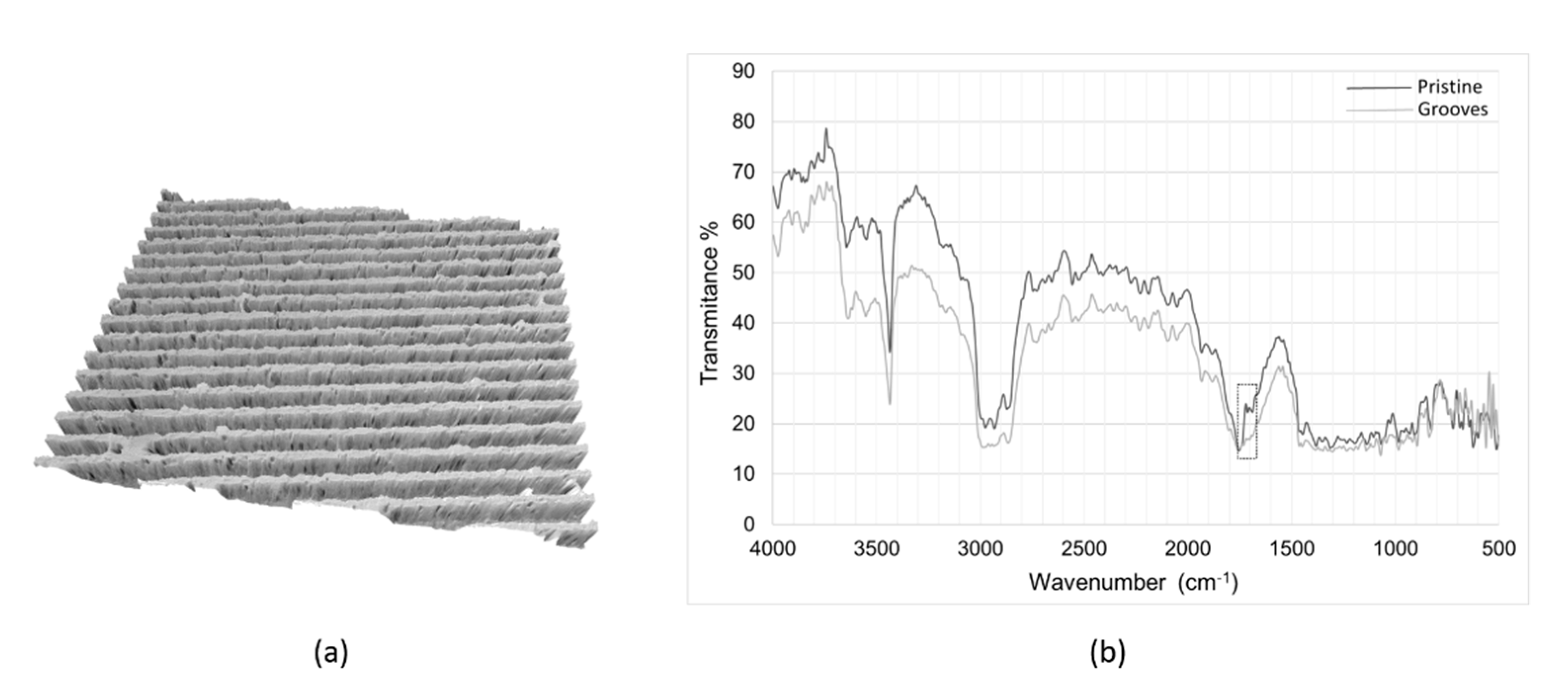
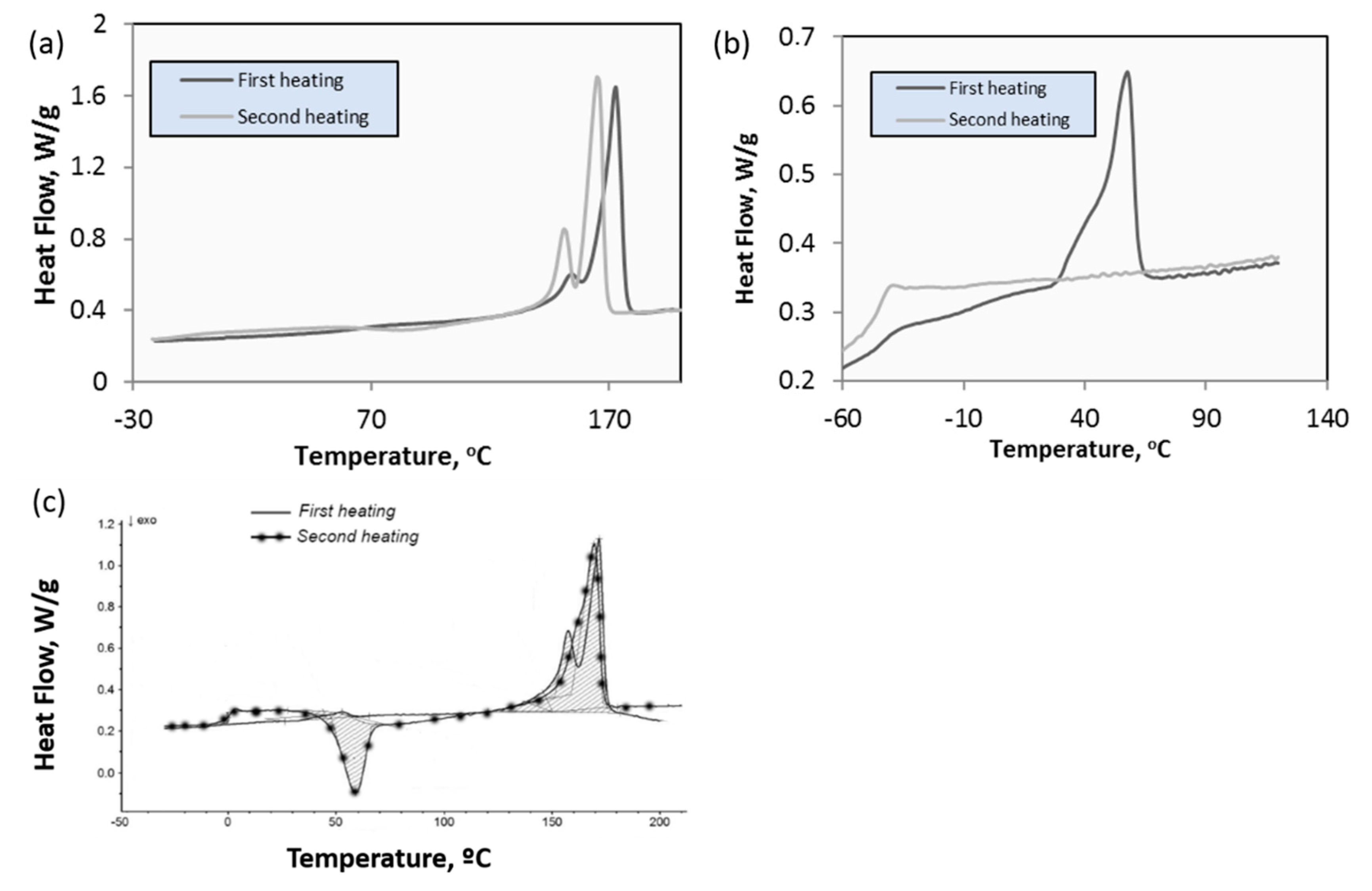
| Materials | Wavelength (nm) | Beam Waist (µm) | Threshold Energy (µJ) | Ablation Threshold (Jcm−2) |
|---|---|---|---|---|
| scl-PHA | 355 | 16.43 | 4.00 | 0.9 ± 0.2 |
| 532 | 13.60 | 6.80 | 2.3 ± 0.3 | |
| mcl-PHA | 355 | 22.6 | 9.40 | 1.17 ± 0.08 |
| 532 | 19.62 | 12.60 | 2.1 ± 0.2 | |
| Blend | 355 | 16.58 | 3.10 | 0.72 ± 0.09 |
| 532 | 13.96 | 3.70 | 1.2 ± 0.2 |
| Tg (°C) | TC (°C) | Tm (°C) | ΔHm (Jg−1) | XC (%) | |
|---|---|---|---|---|---|
| P(3HB) | 2.0 ± 0.1 | 60 ± 2 | 175 | 77 ± 8 | ≈ 52 |
| P(3HO-3HD) | −43 ± 2 | - | 57 | 27 ± 2 | - |
| P(3HB)/P(3HO-3HD) | −0.2 ± 2 | 59 | 170 | 63 | - |
| Mn, kDa | Mw, kDa | σU, MPa | E, GPa | ɛb, % | |
|---|---|---|---|---|---|
| P(3HB) | 110 ± 5 | 800 ± 40 | 36 ± 4 | 1.4 ± 0.3 | 7 ± 2 |
| P(3HO-3HD) | 92 ± 5 | 380 ± 20 | 3.9 ± 0.7 | 1.1 ± 0.1 | 920 ± 100 |
| P(3HB)/P(3HO-3HD) | 22 ± 1 | 1.4 ± 0.2 | 27 ± 2 |
© 2020 by the authors. Licensee MDPI, Basel, Switzerland. This article is an open access article distributed under the terms and conditions of the Creative Commons Attribution (CC BY) license (http://creativecommons.org/licenses/by/4.0/).
Share and Cite
Ortiz, R.; Basnett, P.; Roy, I.; Quintana, I. Picosecond Laser Ablation of Polyhydroxyalkanoates (PHAs): Comparative Study of Neat and Blended Material Response. Polymers 2020, 12, 127. https://doi.org/10.3390/polym12010127
Ortiz R, Basnett P, Roy I, Quintana I. Picosecond Laser Ablation of Polyhydroxyalkanoates (PHAs): Comparative Study of Neat and Blended Material Response. Polymers. 2020; 12(1):127. https://doi.org/10.3390/polym12010127
Chicago/Turabian StyleOrtiz, Rocío, Pooja Basnett, Ipsita Roy, and Iban Quintana. 2020. "Picosecond Laser Ablation of Polyhydroxyalkanoates (PHAs): Comparative Study of Neat and Blended Material Response" Polymers 12, no. 1: 127. https://doi.org/10.3390/polym12010127
APA StyleOrtiz, R., Basnett, P., Roy, I., & Quintana, I. (2020). Picosecond Laser Ablation of Polyhydroxyalkanoates (PHAs): Comparative Study of Neat and Blended Material Response. Polymers, 12(1), 127. https://doi.org/10.3390/polym12010127






